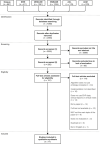Natural language processing algorithms for mapping clinical text fragments onto ontology concepts: a systematic review and recommendations for future studies
- PMID: 33198814
- PMCID: PMC7670625
- DOI: 10.1186/s13326-020-00231-z
Natural language processing algorithms for mapping clinical text fragments onto ontology concepts: a systematic review and recommendations for future studies
Abstract
Background: Free-text descriptions in electronic health records (EHRs) can be of interest for clinical research and care optimization. However, free text cannot be readily interpreted by a computer and, therefore, has limited value. Natural Language Processing (NLP) algorithms can make free text machine-interpretable by attaching ontology concepts to it. However, implementations of NLP algorithms are not evaluated consistently. Therefore, the objective of this study was to review the current methods used for developing and evaluating NLP algorithms that map clinical text fragments onto ontology concepts. To standardize the evaluation of algorithms and reduce heterogeneity between studies, we propose a list of recommendations.
Methods: Two reviewers examined publications indexed by Scopus, IEEE, MEDLINE, EMBASE, the ACM Digital Library, and the ACL Anthology. Publications reporting on NLP for mapping clinical text from EHRs to ontology concepts were included. Year, country, setting, objective, evaluation and validation methods, NLP algorithms, terminology systems, dataset size and language, performance measures, reference standard, generalizability, operational use, and source code availability were extracted. The studies' objectives were categorized by way of induction. These results were used to define recommendations.
Results: Two thousand three hundred fifty five unique studies were identified. Two hundred fifty six studies reported on the development of NLP algorithms for mapping free text to ontology concepts. Seventy-seven described development and evaluation. Twenty-two studies did not perform a validation on unseen data and 68 studies did not perform external validation. Of 23 studies that claimed that their algorithm was generalizable, 5 tested this by external validation. A list of sixteen recommendations regarding the usage of NLP systems and algorithms, usage of data, evaluation and validation, presentation of results, and generalizability of results was developed.
Conclusion: We found many heterogeneous approaches to the reporting on the development and evaluation of NLP algorithms that map clinical text to ontology concepts. Over one-fourth of the identified publications did not perform an evaluation. In addition, over one-fourth of the included studies did not perform a validation, and 88% did not perform external validation. We believe that our recommendations, alongside an existing reporting standard, will increase the reproducibility and reusability of future studies and NLP algorithms in medicine.
Keywords: Annotation; Concept mapping; Entity linking; Evaluation studies; Named-entity recognition; Natural language processing; Ontologies; Recommendations for future studies.
Conflict of interest statement
The authors declare that they have no competing interests.
References
Publication types
MeSH terms
LinkOut - more resources
Full Text Sources
Other Literature Sources


